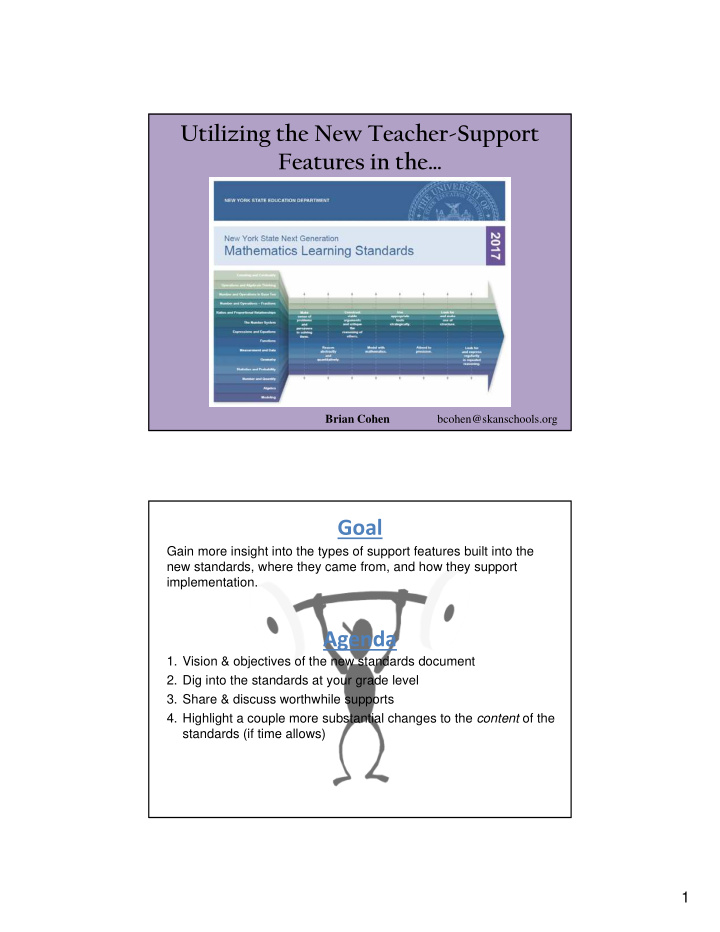



Utilizing the New Teacher-Support Features in the… Brian Cohen bcohen@skanschools.org Goal Gain more insight into the types of support features built into the new standards, where they came from, and how they support implementation. Agenda 1. Vision & objectives of the new standards document 2. Dig into the standards at your grade level 3. Share & discuss worthwhile supports 4. Highlight a couple more substantial changes to the content of the standards (if time allows) 1
CCSS → NYS NGMS In 2012, at UC Berkeley, Bill McCallum talks about the worthwhile residue left behind when the CCSS ‐ M collapses. He offers, for example, that well developed research ‐ based curricula may endure and benefit students long after the CCSS ‐ M. As NYS moves forward from the CCSS, we wanted to: • Keep some the good parts. • Leave behind what didn’t work for us. • Make improvements and upgrades wherever possible. Standards Document ‐ Current 2
Standards Document ‐ Current Standards Document ‐ Current 3
Standards Document ‐ Current Standards Document ‐ Current 4
Standards Document – A better way! yxwvutsrqponmlkjihgfedcbaYVTSRONKHGFDBA Standards Document – A better way! 5
Standards Document – A better way! Standards Document – A better way! 6
wvutsrponihecaTNHF Standards Document – A better way! Note on Fluency with Facts: • Fluently adding and subtracting within 20 (NY-2.OA.2) means students can find sums and differences within 20 reasonably quickly, and say or write it. Fluency involves a mixture of just knowing some answers, knowing some answers from patterns, and knowing some answers from the use of strategies. (10) Reaching fluency will take much of the year for many students. For more on how children develop fluency, see K–5 Progression on Counting and Cardinality and Operations and Algebraic Thinking , pp. 18-19 and Adding it Up , pp. 182-195. ywutsrponmlkihgfedcbaUTPOKFCA Note on Fluency vs. Knowing from Memory : • The standards intentionally distinguish between asking for fluency with addition and subtraction (NY-2.OA.2a) and asking students to know from memory addition facts (NY-2.OA.2b). Fluency means students are fast, accurate, flexible, and have understanding. They use strategies efficiently. (12) By the end of the K–2 grade span, students have sufficient experience with these strategies to know from memory all single-digit sums. (10) Standards Document – A better way! 7
Standards Document – A better way! Standards Document – A better way! • Standards tagging is distinct from, but connected to CCSS • Embed support at point ‐ of ‐ use: o “Coherence Links” to show the vertical coherence of the standards and help teachers differentiate (especially for students with IEPs and ELLs). o Notes and illustrations to clarify individual standards, answer FAQs, or otherwise support implementation o “Within ‐ Grade Connections” to show horizontal coherence o Notes highlighting connections between the Standards for Mathematical Practice and content standards o footnotes from the original standards • Linked navigation • HS standards organized by course (not by Conceptual Category) and tagged to make the course clear • Algebra I and Algebra II shared standards clearly marked 8
Treasure Hunt Treasure Hunt Share & Discuss
Recommend
More recommend